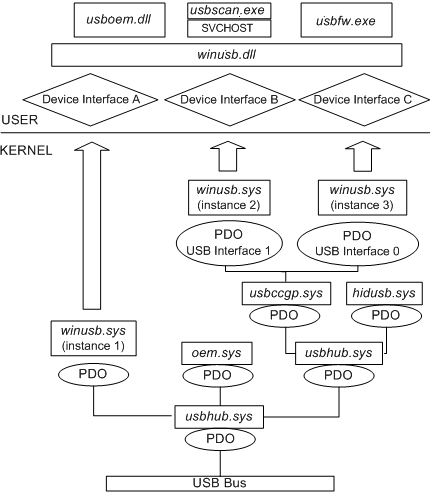WinUSB Architecture and Modules
WinUSB consists of two primary components:
- Winusb.sys is a kernel-mode driver that can be installed as either a filter or function driver, above the protocol drivers in a USB device's kernel-mode device stack.
- Winusb.dll is a user-mode DLL that exposes WinUSB functions. Applications can use these functions to communicate with Winusb.sys when it is installed as a device's function driver.
For devices that do not require a custom function driver, Winusb.sys can be installed in the device's kernel-mode stack as the function driver. User-mode processes can then communicate with Winusb.sys by using a set of device I/O control requests or by calling WinUSB functions.
The following figure shows a USB driver stack that contains several instances of Winusb.sys.

The preceding figure shows an example WinUSB configuration that implements three device interface classes, each of which has a single registered device interface:
- Instance 1 of Winusb.sys registers Device Interface A, which supports a user-mode driver (Usboem.dll).
- Instance 2 of Winusb.sys registers Device Interface B, which supports a user-mode driver for a scanner (Usbscan.exe) that communicates with Winusb.dll by using a system service (SVCHOST).
- Instance 3 of Winusb.sys registers Device Interface C, which supports a firmware update utility (Usbfw.exe).
There is exactly one loaded instance of Winusb.sys. A PDO can represent a non-composite device (for example, instance 1 in the diagram) or it can represent an interface or interface collection on a composite device (for example, instances 2 and 3). For USB wireless mobile communication device class (WMCDC) devices, a PDO can even represent several interface collections. (For more information about PDOs for WMCDC devices, see Support for the Wireless Mobile Communication Device Class.)
Any user-mode application can communicate with the USB stack by loading the WinUSB dynamic link library (Winusb.dll) and calling the WinUSB functions that are exposed by this module.
Related topics
WinUSB (winusb.sys) Installation
How to Access a USB Device by Using WinUSB Functions
WinUSB Functions for Pipe Policy Modification
WinUSB Power Management
WinUSB functions
WinUSB
Palaute
Tulossa pian: Vuoden 2024 aikana poistamme asteittain GitHub Issuesin käytöstä sisällön palautemekanismina ja korvaamme sen uudella palautejärjestelmällä. Lisätietoja on täällä: https://aka.ms/ContentUserFeedback.
Lähetä ja näytä palaute kohteelle